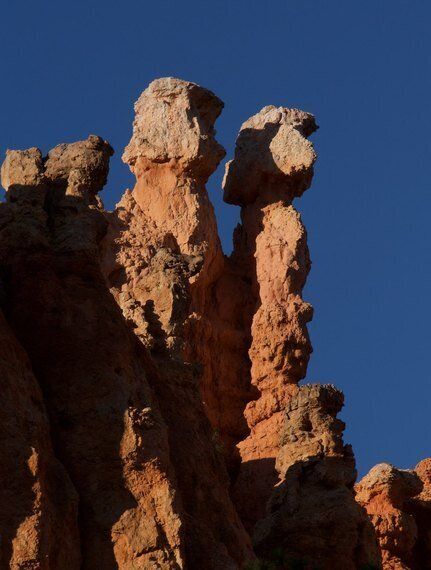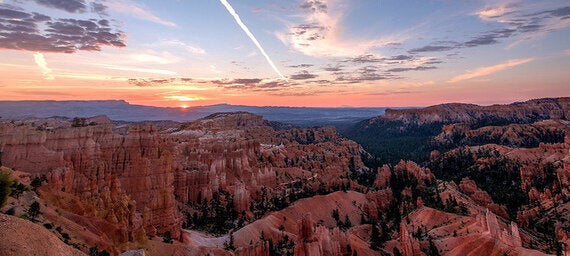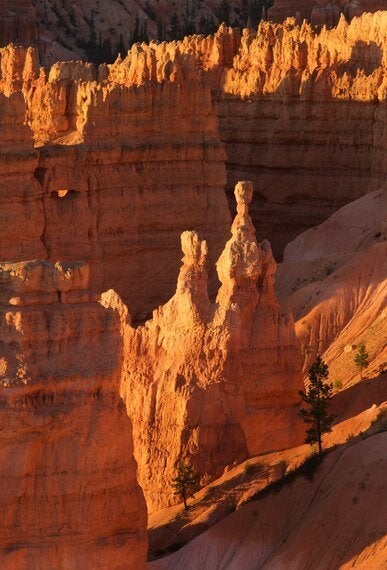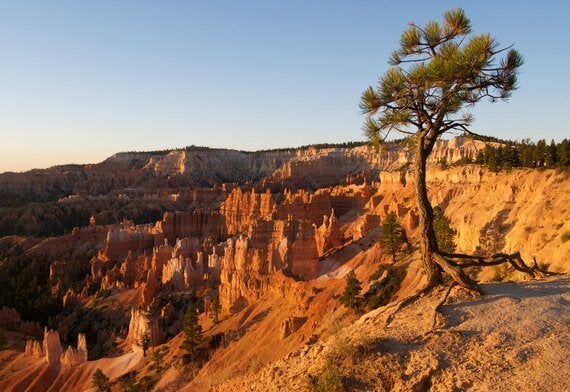
Photos: Rob Bruce
Like many Scots, I love to holiday in the United States. it's a big country and there's a lot to see. I have a precious 15 year old Baedeker guidebook, the pages falling out with overuse. In the flyleaf of the book is a tiny map of the entire country with around a dozen sites picked out. Bryce Canyon is one of them. It has always intrigued me as it was one of the only ones of which I had never heard. So it was great to get an opportunity to visit on a road trip from Salt Lake City to San Francisco this September.
Velvet black dark enveloped us as we stepped out of our car, tired after a long drive. The milky way swirled above us and the air was cold. It is a dark sky park with minimal lighting, and chilly at night due to its elevation. "No air conditioning, no heating, no wifi," the receptionist warned me as I collected the keys. We stumbled our way through shrubs to our cabin, designed in the style of a traditional rustic dwelling, a screen door leading on to a shady porch and a Native American rug on the wall. Using phones as torches we braved the dark again to grab some food. Missing the Lodge restaurant which we later discovered was very nice, we found our way through the darkness to a pizza outlet called 'Valhalla'. A surly waitress stopped stacking chairs long enough to throw an overdone pizza at us, saying the kitchen, presumably manned by Loki, the Norse God of fire, had had no choice but to burn the edges because we had ordered so many toppings. Kind of, "not only is this pizza burnt, but it's your fault'. We now understood the stinker of a review we had seen on Trip Advisor.
The next morning, however, we rose early, keen to see the sites. The guidebook had promised: "Bryce Canyon is one of the most magnificent scenic spectacles in the North American West, whose magical and quickly changing play of colour is seen at its finest at sunrise." Indeed.

A couple of hundred yards from our cabin we found a breathtaking view. The land falls away into an amphitheatre crowded with the most extraordinary, massive and delicate rock formations. They are beautiful sculptures, on a dramatic scale, as if crafted by the Norse God of environmental art. From one angle they could be the ruins of an ancient, alien civilisation. From another they appear twisted, ironic comments on human monuments. One bears a bizarre resemblance to Queen Victoria's head.
The Paiute Indians' storytellers had it that these were the "Legend People" who once occupied the valley and had been turned into stone by Coyote. They called it Unka-timpe-wa-wince-pock-ich, which translates as "Red rocks that stand like men in the shell-shaped gorge".

That's a much better name than the one it has now. Ebeneezer Bryce, for whom the park is now named, was a white settler who farmed cattle here.
It is not a true canyon either, as it wasn't formed by a river. It is on the edge of a plateau where the land falls away and the rock sculptures known as 'Hoodoos', are created primarily by snow which is blown into crevices in the limestone freezing and thawing.
Visitors can wander through the Hoodoos, touching and photographing them. I was annoyed to see one or two people jogging through the canyon, heavy feet thudding as they passed the delicate structures. It was akin to seeing people running through the Sistine Chapel or the Greek vase display at the British Museum. I wanted to slap them. The hoodoos are vulnerable to vibrations which weaken the sandstone at their base.
The Hoodoos will not always be here. Changing conditions will eventually destroy them. In one valley, where 100 years ago Mormon pioneers dug an irrigation ditch with pickaxes, the effect on the conditions has been to destroy the Hoodoos there. This presages the natural changes which will remove them - the average rate of erosion is two to four feet a century.
The park's staff love the park and do their best to take care of it, asking visitors to respect its fragile beauty. It is an extraordinary place, seeming to hover on the edge of existence, not only the Hoodoos, but the lumber trees dotted around. Seeded onto the rock face by little birds, they hang on to life in seemingly impossible situations.

More pictures here https://www.flickr.com/photos/25599199@N00/albums/with/72157658470283550